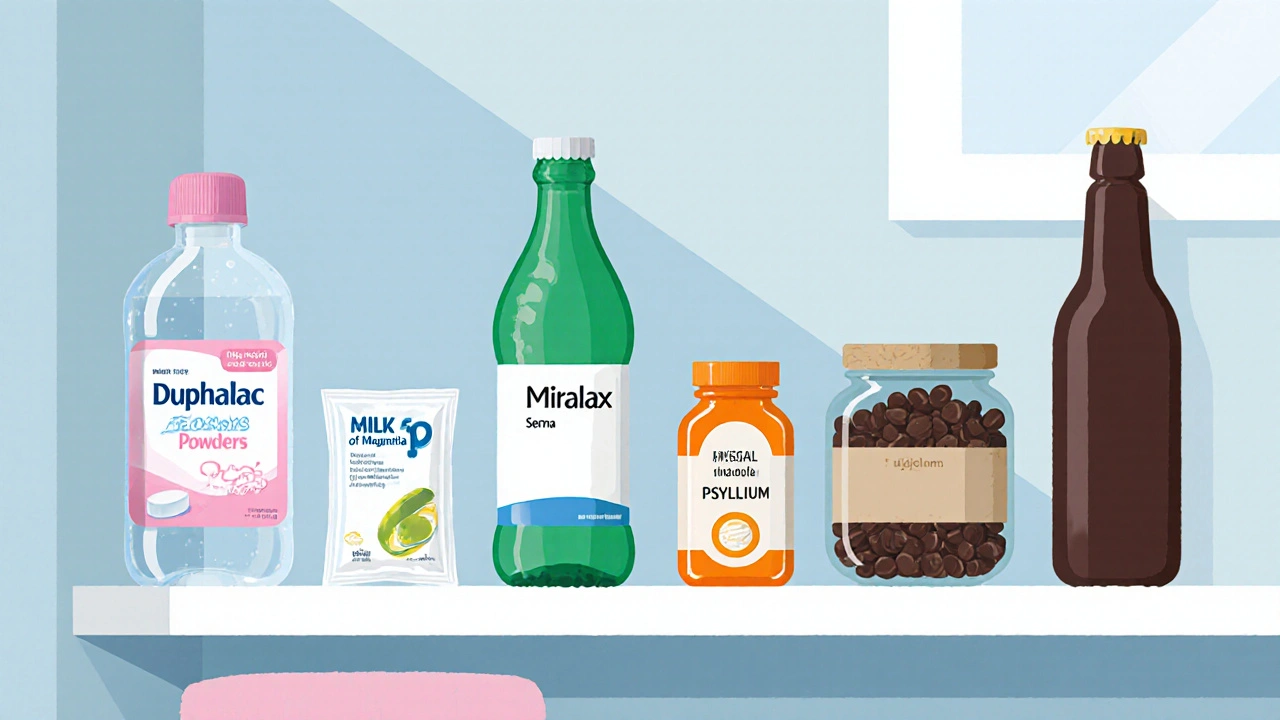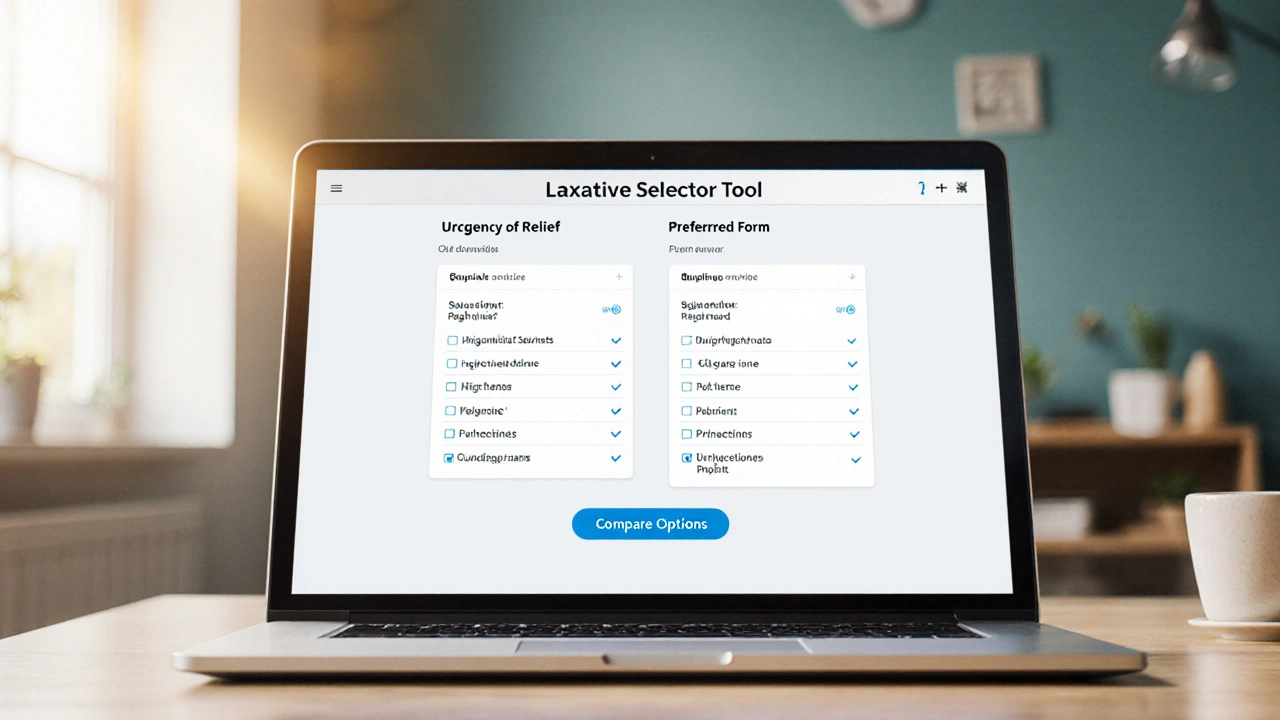Laxative Selector Tool
Select your needs and click "Compare Options" to see the best recommendation.
Key Takeaways
- Duphalac (lactulose) is an osmotic laxative that works by drawing water into the colon and softening stool.
- Miralax (polyethylene glycol) offers a powder‑mix format and is often preferred for mild to moderate constipation.
- Stimulating laxatives such as senna and bisacodyl act faster but can cause cramping.
- Gentle bulk‑forming agents like psyllium or natural options such as prune juice are useful for long‑term bowel health.
- Choosing the right product depends on urgency, tolerance, underlying health conditions, and personal preference.
What is Duphalac (Lactulose)?
When treating constipation, Duphalac is a brand name for lactulose, a synthetic disaccharide that functions as an osmotic laxative. It was first introduced in the 1960s and is widely prescribed in the UK and Europe. The typical dose for adults ranges from 15‑30ml (10‑20g) once daily, adjusted based on response.
Lactulose is not absorbed in the small intestine; instead, it reaches the colon where gut bacteria ferment it into short‑chain acids. This process lowers colonic pH, traps water, and softens the stool, making passage easier.

How Does Lactulose Work?
The osmotic effect creates a gentle pull of water into the bowel, increasing stool volume and stimulating peristalsis. Because the fermentation process is gradual, the onset of action is usually 24‑48hours after the first dose. This delayed effect makes lactulose suitable for chronic constipation but less ideal for rapid relief.
Side effects are generally mild: bloating, flatulence, and occasional loose stools. In rare cases, excessive dosing can lead to electrolyte imbalance, especially in elderly patients with kidney disease.
Common Alternatives to Duphalac
Below is a quick snapshot of the most frequently used alternatives. Each entry includes a brief definition with microdata to help search engines understand the topic.
- Miralax (polyethylene glycol 3350) is an over‑the‑counter osmotic laxative sold as a powder that you mix with water or juice.
- Senna is a plant‑derived stimulant laxative that works by irritating the colon lining, prompting a quicker bowel movement.
- Milk of Magnesia (magnesium hydroxide) is an antacid‑laxative that neutralises stomach acid and draws water into the colon.
- Bisacodyl is a synthetic stimulant laxative available as tablets or suppositories for rapid relief.
- Psyllium husk (a soluble fiber supplement) expands in water, forming a gel that adds bulk and softens stool.
- Prune juice is a natural fruit‑based remedy rich in sorbitol and fiber, offering a mild osmotic effect.
- Constipation (a condition marked by infrequent or difficult bowel movements) affects up to 20% of adults in the UK.
Side‑by‑Side Comparison
| Attribute | Duphalac (Lactulose) | Miralax (PEG 3350) | Senna | Milk of Magnesia | Bisacodyl | Psyllium husk | Prune juice |
|---|---|---|---|---|---|---|---|
| Type | Osmotic | Osmotic | Stimulant | Osmotic/Antacid | Stimulant | Bulk‑forming (Fiber) | Natural osmotic |
| Onset | 24‑48hrs | 1‑3days | 6‑12hrs | 6‑12hrs | 30‑60mins (suppository) | 12‑24hrs | 12‑24hrs |
| Typical Adult Dose | 15‑30ml daily | 17g powder dissolved | 0.5‑1mg tablet | 30‑60ml liquid | 5‑10mg tablet | 5‑10g fiber | 4‑8oz juice |
| Prescription? | Yes (in UK) | No (OTC) | No (OTC) | No (OTC) | No (OTC) | No (OTC) | No (OTC) |
| Common Side Effects | Flatulence, bloating | Gas, mild cramping | Abdominal cramps, urgency | Diarrhoea, electrolyte shifts | Cramping, sweating | Bloating if not enough water | Gas, mild diarrhoea |
| Best For | Chronic constipation, hepatic encephalopathy adjunct | Gentle daily maintenance | Fast relief when time‑pressured | People who also need antacid | Acute constipation, hospital setting | Long‑term bowel regularity | Natural‑food‑based approach |

Factors to Consider When Choosing a Laxative
Speed of relief matters if you need to clear the bowels before a procedure. Stimulants like senna and bisacodyl give the quickest results, often within a few hours.
Duration of use is another key point. For chronic constipation, doctors usually recommend osmotic agents (lactulose, PEG) or bulk‑forming fibers because they are gentler on the colon over months.
Underlying health conditions shape the decision. Patients with renal impairment should avoid magnesium‑based products (Milk of Magnesia) due to the risk of hypermagnesemia. Those with diabetes need to watch the sugar content in prune juice.
Medication interactions also play a role. Lactulose can affect the absorption of certain antibiotics, while stimulant laxatives may interfere with heart medications that alter gut motility.
Personal preference - taste, form (liquid vs powder vs tablet), and convenience - often decides adherence. Some people hate the sweet taste of lactulose syrup, making a powder like Miralax more appealing.
Practical Tips for Safe Use
- Start with the lowest effective dose. For lactulose, a half‑dose (7.5ml) can be enough for mild cases.
- Increase fluid intake. Fiber‑based options (psyllium, prune juice) require at least 8cups of water a day to prevent worsening constipation.
- Track your response. Keep a simple log of stool frequency, consistency (Bristol Stool Chart), and any side effects.
- Don’t combine stimulant and osmotic agents without medical advice; the combo can cause severe cramping.
- Consult a GP if you experience >3days of watery diarrhoea, severe abdominal pain, or signs of electrolyte imbalance.
Frequently Asked Questions
Can I use Duphalac for occasional constipation?
Yes, but because it takes 1‑2days to work, many people reserve it for chronic cases. For occasional relief, a stimulant like senna or a small dose of Miralax may be faster.
Is lactulose safe for children?
Pediatric doses are much lower (around 1‑2ml/kg). It is prescribed for children with constipation or for hepatic encephalopathy under specialist supervision. Always follow a doctor's guidance.
How does Miralax differ from Duphalac chemically?
Miralax contains polyethylene glycol 3350, a large inert polymer that holds water in the gut. Lactulose is a disaccharide that is fermented by bacteria, producing acids that lower colonic pH. Their mechanisms are both osmotic but act via different pathways.
Can I take lactulose and a fiber supplement together?
Generally it’s safe, but the combined bulk may increase bloating. Start lactulose alone, then add a fiber supplement if needed, monitoring for tolerance.
What should I do if I experience severe cramping with senna?
Stop the senna immediately and hydrate well. If cramping persists, switch to a gentler osmotic laxative like lactulose or PEG, and consult your GP.
Whether you’re managing chronic constipation, preparing for a medical exam, or just looking for a smoother daily routine, understanding how Duphalac stacks up against its peers helps you make an informed choice. Remember: the “best” laxative is the one that fits your health profile, timing needs, and personal comfort.

jeff lamore
October 5, 2025 AT 17:10Thanks for putting together such a thorough comparison. The table makes it easy to see the different onset times and side‑effect profiles. I appreciate the note about fluid intake when using fiber‑based products. It’s good to be reminded that lactulose can take 24‑48 hours, so it’s not ideal for last‑minute situations. Overall a solid reference for anyone deciding on a laxative.
Kris cree9
October 12, 2025 AT 20:00Yo, this thing sounds like a corporate ploy to push pricey syrups over cheap prune juice… who even needs 30 ml of sugary liquid when a glass of juice does the job? Stop feeding us the “doctors choise” nonsense!!!
Paula Hines
October 19, 2025 AT 22:49Duphalac is often the go‑to for chronic constipation because it works gently and can be taken long term The osmotic action draws water into the colon which softens stool without causing the harsh cramping sometimes seen with stimulant laxatives The slow onset of 24 to 48 hours means patients must plan ahead especially before medical procedures The fermentation by gut bacteria also lowers colonic pH which can be beneficial for certain gut flora The prescription status in the UK ensures medical oversight but can be a barrier for some who prefer over‑the‑counter options The comparison table rightly highlights Miralax as a powder that many find more palatable especially when mixed with juice The bulk‑forming agents like psyllium require plenty of water and proper dosing to avoid worsening constipation The natural route of prune juice provides sorbitol and fiber making it a gentle alternative for occasional use The electrolyte concerns with magnesium‑based products are valid for patients with kidney disease especially the risk of hypermagnesemia The note about lactulose interacting with antibiotics is something clinicians should keep in mind The cost factor is also important as Duphalac can be pricey compared with generic PEG formulations The patient’s taste preferences often dictate adherence because the sweet syrup can be off‑putting for some The slow steady relief offered by lactulose aligns well with maintenance therapy for hepatic encephalopathy where it also reduces ammonia levels The table also correctly points out that bisacodyl works fast but may cause urgency that is inconvenient for daily life The emphasis on fluid intake applies across all osmotic agents and is a simple yet essential advice The overall message is that there is no one‑size‑fits‑all laxative and the choice should be individualized based on speed, side effects, health conditions and personal preference
John Babko
October 27, 2025 AT 01:38Indeed, the comprehensive breakdown is invaluable, especially for clinicians who must balance efficacy, cost, and patient comfort; the table’s clarity on onset times, dosage forms, and side‑effect profiles makes decision‑making far more straightforward, and the reminder about adequate hydration cannot be overstated.
Stacy McAlpine
November 3, 2025 AT 04:27Great summary! For someone who just wants a quick fix, the fast‑acting options like senna or bisacodyl are the way to go. If you’re dealing with long‑term constipation, stick with lactulose or PEG. Also, remember to drink plenty of water with any fiber supplement.
Roger Perez
November 10, 2025 AT 07:16Exactly! 😊 Staying hydrated is key, and it’s good to have both quick and gentle choices handy. 👍 If you’re not sure which to start with, a low dose of lactulose can be a safe first step.
michael santoso
November 17, 2025 AT 10:05The analysis, while thorough, fails to address the socioeconomic implications of prescribing brand‑name Duphalac over generic alternatives, thereby overlooking a critical dimension of patient accessibility that warrants deeper examination.
M2lifestyle Prem nagar
November 24, 2025 AT 12:54True point, cost matters for many patients.
Karen Ballard
December 1, 2025 AT 15:43Loved the clear table! 🎉 It makes picking the right laxative a breeze. 💡